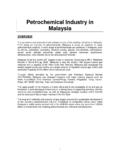Transcription of Globalisation, Economic Policy, and Equity: The …
1 3. 3 RRYYH. HUUWW\\ D. DQ QGG ,,Q. QFFRRPPHH ,,Q. QHHT. TX XDDOOLLWW\\ LLQ. Q '. 'H HYYH HOOR. RSSLLQ. QJJ & &R. RXXQ QWWUULLH. HVV . $$ 33 RROOLLFF\\ '. 'LLD. DOOR. RJJX. XHH R. RQQ WWKKHH ( (IIIIHHFFWWVV R. RII *. *OOR. REEDDOOLLVVD. DWWLLR. RQQ. 30 November-1 December 2000. 9, rue de la F d ration, 75015 Paris (OECD-IEA / OCDE-AIE). globalisation , Economic policy , and equity : The Case of malaysia by Mohammed B. Yusoff Fauziah Abu Hasan Suhaila Abdul Jalil OECD Development Centre: 94, rue Chardon-Lagache, 75016 Paris Tel.: ( ) 45 24 82 00 Fax: (33 1) 45 24 79 43.))
2 globalisation , Economic policy , and equity : The Case of malaysia Mohammed B. Yusoff Fauziah Abu Hasan Suhaila Abdul Jalil PAGE i TABLE OF CONTENTS. Introduction 1. Macroeconomic Performance and Development policy 3. Natural Resources, Factor Endowments and Ownership 3. The Structure of the Economy and Growth Performance 4. Industrial Development policy 6. Integration of the Malaysian Economy 8. Trade Liberalisation Exports, Imports and Terms of Trade 8. Trade Liberalisation Programmes 10. Generalised System of Preferences 11. Migrant Workers 11.
3 Financial Liberalisation Domestic Financial Reforms 12. Capital Flows 13. Exchange Rate Regime 14. Foreign Direct Investment (FDI) 14. Domestic Investment 16. Privatisation 17. Income Inequality and Poverty 18. Income Inequality 18. Income Inequality among the Ethnic Groups 20. PAGE ii Rural-Urban Income Inequality 20. Poverty Measurement of Poverty 21. Incidence of Poverty 22. Rural-Urban Poverty 23. Poverty among the Ethnic Groups 24. Government Policies on Inequality and Poverty 24. Economic Development, Integration and Poverty 26.
4 globalisation and Government Policies 28. Education, Training and Knowledge-Based Economy 28. Development of Small and Medium Scale Industries (SMIs) 30. Assistance to Hard-Core Poor 31. Expansion of Domestic Food Production 31. Development of Science and Technology and R&D 32. Conclusions and policy Implications 33. Summary of Findings 33. policy Implications 34. Appendix 35. References 38. PAGE iii globalisation , Economic policy , and equity : The Case of malaysia Mohammed B. Yusoff Fauziah Abu Hasan Suhaila Abdul Jalil 1. INTRODUCTION.
5 Prior to 1957, the Malaysian economy was heavily dependent on primary products, specifically tin and rubber, to generate growth and employment. The role of manufacturing was quite minor involving the processing of rubber, tin, timber, foodstuffs and light engineering works. Initially, malaysia pursued a development strategy that focused on the diversification of agricultural exports as a means to stabilize its export earnings and income. Over the next few decades, malaysia developed rapidly and experienced a transition from agriculture to industry.
6 These structural adjustments occurred due to the deliberate government policies to industrialize the economy through the import substitution and export-oriented industrialization strategies. The Malaysian development policies are clearly spelt out in her 5-year development plans called the malaysia Plan that emphasises growth with equity in the context of multi-racial society. Prior to the 1970s, there was a serious Economic imbalance in malaysia in the areas of distribution of income, employment, ownership and control of Economic activity.
7 PAGE 1. After the 1969 racial riot, malaysia realized the importance of growth with equity and therefore it was decided that the Economic development of the country must be equitably shared by all the ethnic groups. Toward this end, malaysia introduced the New Economic policy (1971-90), followed by the National Development policy (1991-2000). The main objective of the two Economic policies is to eradicate poverty irrespective of ethnic groups. Those who are poor must be assisted and equipped with training and necessary resources to improve their standard of living.
8 As a result of successful implementation of the poverty eradication policies, malaysia was able to significantly reduce the incidence of poverty from percent in 1970 to percent in 1995. The income share of the top 20 percent of the households fell from percent in 1970 to percent in 1989 while that of the bottom 40 percent increased from percent to percent in the same period. Accordingly, the distribution of income among the households improved as indicated by the fall in the Gini coefficient from in 1970 to percent in 1989. The more equitable wealth distribution coupled with high Economic growth spearheaded by the vibrant external sector in the last three decades have been translated into racial integration and political stability.
9 Along this line, IMF argues that policies that promote equity have the ability to reduce poverty because when income and wealth are more evenly distributed, the number of people below the poverty line decreases. Furthermore, equity -enhancing policies, particularly investment in human capital, can boost Economic growth in the long run and thus alleviate poverty and reduce political conflicts (IMF, Finance and Development, 1998). PAGE 2. globalisation has provided several positive and negative effects to the Malaysian economy, particularly in terms of income distribution, employment, and the need for skilled and educated workforce and labour policy and planning.
10 Obviously, globalisation has had positive results on the country's Economic growth through trade expansion and foreign direct investment that opened new channels for Economic expansion. Thus, during the rapid globalisation periods of 1980s and 1990s, the Malaysian economy became more integrated with the world economy; her share of exports and imports in GNP rose by about 75 percent. This was translated into a buoyant Economic growth as malaysia grew at about 8 percent during the 1987-97 period spearheaded by the exports of manufactures.















